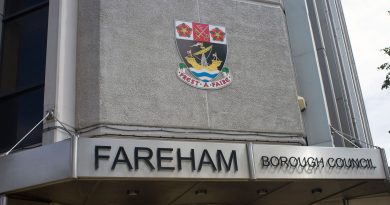Diving Museum gets permission for ‘exemplar’ heating system
By Chief Correspondent Rob Thomas
Gosport’s Historic Diving Society has been given the go-ahead to install a heating system that will be an important step in opening up more space for its museum at Stokes Bay.
Permission is required because the museum is housed in No. 2 Battery which is a Grade II* Listed building.
Museum Director Kevin Casey explained that the underfloor heating system is needed to equalise the temperatures between different parts of the building and prevent damp in the lower levels.
He told The Globe: “We’re going to use an air source heat pump. It has never been used in such an old building and part of the [awaited] grant is for sensors to measure the environment to see if it works and could then be used as an exemplar.”
The officer’s report to Gosport Borough Council’s Regulatory Board which considered the planning application stated: “The heating system would be comprised of a mixture of thermal insulation and pipework, but principally would have a separating membrane from the fabric of the Listed Building and no part would be permanently attached.
“Pipes from the underfloor heating to the external heat pump would run through existing holes in the walls.
“The proposed external heat pump would be discreetly sited in the north-west corner of the fort”.
No objections to the plan were received by the council.
Mr Casey is a ward councillor and Vice Chair of the board, and so he left the chamber during the discussion and approval of the application.
Having obtained the permission, the diving society is now waiting for Arts Council England to award a grant of £100,000 towards the expected cost of £115,000.
Seven Eagle Diving Bell
A second Historic Diving Society application considered by Regulatory Board was to replace a badly deteriorated North Sea saturation diving bell with the Seven Eagle Diving Bell.
Weighing in at over ten tons, the plan is for this 3.27m high diving bell to be exhibited in the grassed area to the south of No. 2 Battery on a new ‘floating’ concrete base.
No objections to the application had been lodged with the council and the officer’s report noted the siting of the bell, “would retain key views of the Listed Building and would be of a scale and siting similar to other exhibits.”
Again, Vice Chair Kevin Casey was not in the chamber when the board discussed and approved the application.
After the meeting he told The Globe: ““the Eagle had a wonderfully long and productive life as a Diving Support Vessel, one project of note is that this bell was used on the original “Proof of Life” Mission on the downed Russian Submarine Kurk when 118 submarines were lost.”
The volunteer-run Diving Museum – which in 2015 was placed in the top six of Kids in Museums’ ‘family friendly’ museums – is now closed for the winter and will reopen on April 2, 2022.
Photograph (top): the Seven Eagle Diving Bell on board the ship. Historic Diving Society, reproduced with permission



